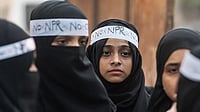The most striking feature about Kesarabai Dinaji Gotmukke, a veteran activist of the Dalit Panthers and the leader of the women’s wing of the organisation, is her voice. For a 93-year-old, the voice is strong with an authoritative ring to it. When Kesarabai speaks, the room falls silent and everyone listens. Hers is the voice that united the Dalit women of Nanded in the Marathwada region of Maharashtra over 50 years ago, and brought illiterate women out on the streets to demand and fight for their rights.
Kesarabai exudes a confidence which is a rarity in women like her—illiterate and a Dalit. “My age is not a barrier. I can travel anywhere to spread the message of Babasaheb Ambedkar. It is because of him and his teachings that people from all over the world come to meet me,” she says. She braved a morning of heavy rains to reach the house of the late S M Pradhan, a Dalit Panthers icon who took to the streets in Nanded, united the Dalit community and created the organisation in this district, along with some others.
She is a firebrand leader who took the teachings of Ambedkar to the poor and the downtrodden Dalit families through the musical renditions of Ambedkar’s teachings. She has her own bhajan group that visits homes when people die and sings devotional songs. “The chulha in my home burns when someone dies. That is the only time we get a sizeable amount of money. Otherwise, it is a hand-to-mouth existence,” says Kesarabai.
On May 28 and 29, 2022, Nanded was witness to a historic conference when the Black Panther Party of USA and the Dalit Panthers of India, came together on a common platform to discuss the issues facing both sides of the divide. The occasion was the golden jubilee celebrations of the Dalit Panthers of India. Icons such as Henry Gaddis, Michael D McCarty, J V Pawar and Indira Athawale provided insights into the movements in both countries which provided a new language of self-respect. Illiterate herself, Kesarabai addressed this international conference and drew accolades from the delegates.
Ambedkarite Buddhism mixed with the militant self-defense style of the Black Panthers was adopted as the ideology by the founders—J V Pawar, Namdeo Dhasale and Raja Dhale—of the Dalit Panthers movement in India. “Nanded became the city of revolution. The Dalit Panthers of Nanded were fiery and aggressive and fought hard for their rights,” says Suraj Yengde, an Ambedkarite scholar and a doctorate who authored Caste Matters.

“I will forever be indebted to Siddharth M Pradhan, popularly known as “SM”. He lived in penury yet he never compromised on his ideals. That is my takeaway from my long-term association with him and his family,” says Kesarabai sitting in front of a wall covered with the framed photographs of leaders who have been icons for the world in various struggles. Kesarabai wears the traditional nauvari sari—the nine-yard wrap worn by the women in rural Maharashtra. A round red vermillion bindi, covering a better part of her forehead, an ear adorned with multiple earrings, teeth blackened by the constant use of masheri—burnt tobacco and salt powder used as tooth cleaner—wrists with the coloured glass bangles and a finger with its lone silver tortoise ring add to her persona.
Kesarabai says she wears the ring with the tortoise motif for prosperity. Each day of her 93-year-old life has been spent in various stages of poverty. “Had I been educated, maybe life would have taken a different turn. My father, Jhalba Suryawanshi, and my mother, Limbabai, were both farm labourers. Money, food and all comforts were scarce. We never had dreams, we were afraid to dream,” says Kesarabai.
The birth of the Dalit Panther movement in Nanded is intrinsically linked to the emergence of the Jai Bhim Nagar slums—a settlement of the Dalit community that was more than 50 years old—which became the nucleus of the Dalit Panthers movement in Nanded. The story dates back to the late 1960s when the Maharashtra government had built 700 houses as part of the rehabilitation scheme for the residents of the Degaon Chawl in Nanded. This settlement, located on the banks of river Godavari, would get flooded every monsoon and the people would be evacuated to safer places. So the houses were built for them as a permanent solution. However, when the residents of Degaon visited the locality where they were allotted the new houses, they refused to take it as the houses were smaller in size than those they lived in.
During this period, Kesarabai had worked as a farm hand in the fields of the agriculture university in Nanded. It is here that she had heard that the Degaon residents had refused to live in the houses built for them by the state government. “We were homeless. These houses were lying vacant. Our leader, S M Pradhan, told us to occupy these houses. We encroached and called it Bhim Nagar,” says Kesarabai. The struggle to get it in their names began after they had occupied the houses. Thus began the first struggles of the Dalit Panthers in Nanded. Bitter battles were fought on the streets of Nanded and protest rallies were held in the erstwhile Bombay for the right to the live in the houses in Bhim Nagar.
The birth of Bhim Nagar also saw the emergence of the Mahila Morcha of the Dalit Panthers, first in Nanded and then across Maharashtra. Led by Tulsabai Sonovne and Kesarabai, the Mahila Morcha became a pressure group for the Dalit Panthers. They would participate in agitations and travel across Nanded generating awareness among the Dalits to live a better life. Kesarabai and Tulsabai lent music to the teachings of Babasaheb Ambedkar and would travel around Nanded creating awareness about the rights of the Dalits. “The women of Bhim Nagar were at the forefront. They were responsible for lending aggression to the movement,” says Rahul Pradhan, the activist son of the late S M Pradhan. Back then, as the agitation progressed, the women of Bhim Nagar went to jail many times, including the jails of Bombay where they would converge for agitations. “Only after the trains from Nanded reached Bombay with the activists would any morcha (a meeting or rally) start. That was the importance of the Dalit Panthers of Nanded,” says Pradhan.
“Nanded is one of the most important centres that brought the Dalit Panthers movement into focus,” says Vijay Shankarrao Sonovne, the chief editor of Daily Dalit Guard, a newspaper founded by him.
A childhood friend of S M Pradhan—who later became his brother-in-law—Sonovne takes us through the historical by-lanes of the Dalit Panthers and its connection to Nanded. The first of the agitations was about 50 years ago, when students of the Narsing Vidya Mandir launched an agitation against the principal for eve-teasing a female student. “I was in class 9. We blackened the face of the principal, made him sit on a donkey and paraded him around the city,” narrates Sonovne. He had spent 20 days in jail, after the principal lodged a police complaint. “We beat up anyone who eve-teased and harassed women. We became a pressure group,” says Sonovne.
Bhim Nagar became the epicentre for all agitations. During the agitation to rename Marathwada University as Bhimrao Ambedkar University, this slum settlement became the mainstay of the agitation. Men, women, the young as well as the old from Bhim Nagar started a sustained agitation against the state government and violence became an everyday occurrence. “There was a policeman called Paliwar, who had come to stop the agitation. We, the women, pushed him into the police van, surrounded it and beat him black and blue. His clothes were torn and he ran for his life. Even today, policemen are scared to enter Bhim Nagar,” narrates Kesarabai. Her tin-roofed house in the slum colony mirrors the poverty of her family.
Dwarkabai Gaikwad, another Dalit Panthers activist from yesteryears, deplores the lack of respect the younger generation has towards all those who fought against caste discrimination and for the rights of the Dalits. “Bhim Nagar exists because of our campaign. These youngsters laugh at us and tease us when we talk about the past glory of the Dalit Panthers. There is complete moral bankruptcy among these youngsters,” says Dwarkabai, who was once arrested with her one-month-old child. “I had gone to Bombay with my one-month-old child to participate in the renaming agitation. There were hundreds of us from Nanded. All of us were arrested by the police. We gave them such a hard time that the Mumbai Police will never forget us,” narrates Dwarkabai.
Modern-day Bhim Nagar mirrors this apathy Dwarkabai refers to. At the entrance of the slum settlement stands the monument of Gautam Waghmare, who had immolated himself to protest the naming of the Marathwada University. This incident took place at the entrance of Bhim Nagar and had hastened the renaming of the university. Today, the monument to commemorate the sacrifice of Waghmare is a forgotten and neglected relic. Many of the younger generation from Bhim Nagar do not understand the significance of the monument.
Though a majority of the Dalit Panthers leaders who made a mark in Nanded and had once lived in Bhim Nagar, including Rahul Pradhan and Suraj Yengde, they have moved on since then. “I see myself as someone who carries a responsibility. I am involved in the community and I feel that every movement needs a new philosophy. I feel that the old ideas need to be thought through,” says Yengde. According to him, Nanded has been a place of revolutionaries and there is always an intent to relaunch the Dalit Panther movement.
However, Sonovne is sceptical about a rebirth. During the years of the Emergency, the Dalit Panthers was disbanded. “The activists were arrested from their homes. Many of them went underground. Raja Dhale, who was one of the founders of the Dalit Panthers, disbanded the Dalt Panthers after his arrest,” says Sonovne. Disagreements followed the disbanding, and soon the Bharatiya Dalit Panthers was established in 1978 in Aurangabad by Arun Kamble. S M Pradhan, Ramdas Athavale and many others became a part of this new outfit. Until the 1990, when the Dalit Panthers merged with the RPI, agitations against the caste hierarchy were the mainstay of the Dalit Panthers.
“I hated agitations, poverty and everything my father stood for,” says Rahul Pradhan. “Survival was such a struggle. It is only after I grew up and joined the movement that I realised the enormity of my father’s work and struggles,” he says. He feels that a resurgence of the Dalit Panthers is not possible today as the political situation is different today.
“The fragmented Dalit leadership and the political alliances of each faction of the RPI make it difficult for the Dalit Panthers to make a comeback,” says Prakash Mohale, a Dalit researcher. “There is a lack of direction and an ideological deficiency among the Dalit youth,” says Mohale.
(This appeared in the print as 'The Nanded Milepost')


























